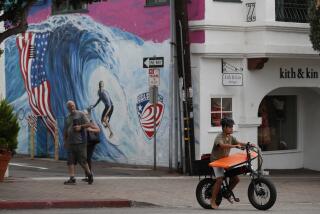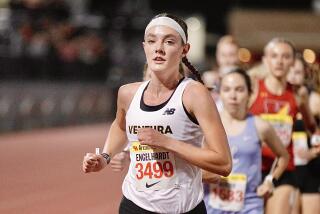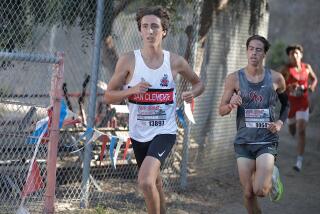Organizers Turn Surf City 5K Into Stroller Derby
- Share via
The competitors clogged the starting line 10 deep at the Surf City 5K in Huntington Beach last week. The more serious packed the front, the cautious and casual filled the rear.
Somewhere in between, 9-month-old Amory Yagar of Huntington Beach clapped his hands and waved toward the sky. His wide blue eyes said this was more than just another trip through the neighborhood.
This was a race against his peers.
When organizers added a stroller race to the annual Fourth of July event a few years ago, it not only thinned out the residents’ and open 5K races, but also lured participants who might have otherwise stayed home.
Most races ban strollers for safety reasons. But Surf City race officials and many parents say that a well-organized strollers-only race can be a safe--and fun--way to include children.
“It’s great,” said Amory’s mother, Leslie Yagar. “I can get out of the house with him and he enjoyed it. And it was fun to run with other parents.”
Thorsten Hegbert of Huntington Beach was the first of 73 participants to cross the finish line. Hegbert, who pushed his sons, Taigen, 2, and Quinten, 4, placed third in 1998 and was second last year.
“I figured I had to go for first this time,” said Hegbert, who finished in 16 minutes 37 seconds. “We started training about three weeks before this.”
Hegbert teaches sixth grade in Costa Mesa and during the summer is a lifeguard. With the additional responsibilities that come with raising two young children, finding time to run on his own could take a few years.
“I’d like to do more road races, but with two kids and working, I don’t have the time or the money,” Hegbert said. “Summer time is usually stroller time.”
Daniel Rosales of Pomona ran with a stroller for the first time in the Surf City 5K.
Rosales, who finished seventh in the open 5K earlier this year at the Pacific Shoreline Marathon in Huntington Beach, thought the Surf City race would be a good opportunity to experiment with a stroller. He has a newborn daughter and would like to include her in his running when she gets older.
So, Rosales borrowed his nephew and a friend’s stroller and finished second in 17:55.
“It was kind of different running with just one arm,” Rosales said. “I was all over the place.”
Anet Meyer of Tustin braved the front line at the start of the race. Meyer, who runs five days and averages 40 miles a week with her stroller, jumped at the rare opportunity to compete, finishing second in the women’s division in 19:44.
“There’s not any race that I know of that has a stroller division,” said Meyer, whose pre-motherhood results include a victory in the women’s 5K at the 1998 Pacific Shoreline Marathon.
Although last week’s stroller race was accident-free, the Road Runners Club of America, the largest running organization in the United States, strongly recommends against baby strollers participating in road races and race organizers creating baby stroller divisions.
According to the organization’s literature, the inclusion of strollers in races increases the potential for injury to race participants and the children.
The RRCA has no objection to the safe and prudent use of strollers in training situations. Most race organizations adhere to RRCA guidelines but often don’t mention such restrictions in race fliers or brochures.
Mike Cook, an RRCA regional race director from Midlothian, Va., said he agrees with his organization’s stance against including strollers in open races, but thinks the idea of a separate race for strollers is a good one.
“I think it’s a very unique idea,” Cook said. “The reason they don’t want strollers in open races is they can trip up other runners. If it’s just a stroller race, then I guess they only take the chance of getting tangled up together.”
Last year, runners pushing strollers were mixed in with the open race in Huntington Beach, and Hegbert said it was a mess, with people stumbling over strollers at the start.
“I called before the race this year to make sure the stroller race was going to be separate,” Hebert said. “I told them, ‘If you don’t do a separate race, I want my money back.’ I needed a guarantee that it was going to be separate.”
Hegbert usually runs with his stroller in the early evening and said he takes several safety precautions. He includes a flashlight for his boys to handle during the ride and he sticks a blinking red light in his back pocket. He doesn’t put helmets on the boys because, he says, they’re already strapped into a three-point harness, and he also makes sure he wears another safety strap around his wrist.
“It has come in handy once or twice,” Hegbert said. “At the end of the race last year, I lost my balance and pulled a big wheelie at the finish line. I might have lost the stroller if it wasn’t for the wrist harness.”
STROLLER SNIPPETS
The first three-wheeled racing strollers began showing up nearly 20 years ago, but the once-controversial and poorly-designed models have been replaced by sleeker, safer equipment that allow parents to incorporate children in their workouts.
Today’s models range in price from $150 to $400 and can be purchased at most bicycle shops and baby stores.
John Pavlisin, owner and manager of Orange Cycle, says the questions most often asked have to do with assembly and collapsibility.
“A lot of people want to know how easy they are to transport,” Pavlisin said. “I personally take mine to a lot of places, like the mall.”
Buying a stroller, however, does require knowledge. The American College of Sports Medicine in Indianapolis offers advice for baby-stroller consumers.
* The lighter the stroller, the more you will enjoy pushing it.
* The seat varies between models--from plastic to machine-washable fabric. Some models have deeper, wider seats for larger children and padded frames in the seating area.
* Look for features such as an adjustable handle to suit the height of the runner, a sun or rain canopy and a carrying pouch. Check to see if the stroller can be expanded to include another seat.
* Check for models that include wheel covers or other protective devices to prevent children from poking their fingers in the spokes.
* A quality retailer should encourage you and your child to test models.
“The ACSM emphasizes the importance of using a jogging stroller safely,” the national organization writes in a 1997 issue of its newsletter, Current Comment. “All jogging strollers should have standard safety features, such as a deep seat with seat belt, a locking brake and a safety wrist strap. These standard safety features are essential.”
*
If you have an item or idea for the running report, you can fax us at (714) 966-5663 or e-mail us at dan.arritt@latimes.com.
More to Read
Sign up for Essential California
The most important California stories and recommendations in your inbox every morning.
You may occasionally receive promotional content from the Los Angeles Times.













